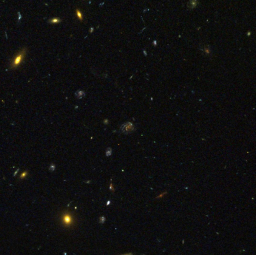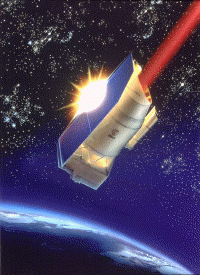
Three colour (BVI) image of a distant overdense region of galaxies taken by the Hubble Space Telescope. The image is focused on a spiral galaxy similar to the Milky Way but located at z = 1, i.e. 8 billion years ago. Twice the mass of the Milky Way, it has a star formation rate thirty times higher due to the surrounding galaxy overdensity.
Observational Cosmology has reached an important turning point. After years of seeking the parameters that govern the evolution of the Universe, there seems to be increasing consensus in acknowledging the dominant influence of dark matter on baryons and that of dark energy on dark matter. Paradoxically, the behaviour of the two “dark” components that make up 95% of the energy content of the Universe is easy to model (dark matter is nondissipative and subject only to gravity, while dark energy acts as an anti-gravitational factor), even though our knowledge of their nature remains highly speculative. This has led to the scientific community’s leaning increasingly toward what has become the conundrum that best stands up to theoretical attack: the behaviour of baryons and the origin of the light we receive from stars, galaxies and galaxy clusters. It is now acknowledged that it is not possible to understand how galaxies form and evolve without using the entire electromagnetic spectrum to study their various components (stars, gasses and dust) in their different states (neutral, ionized, young/old, dense/not very dense).

